Pepperidge Farm built on earlier projects and solid in-house engineering to construct a powerhouse bakery.


The size and scope of Pepperidge Farm's new Bloomfield, Conn., bakery are impressive: a $72.1 million project involving ground-up construction of a 265,000-sq. ft. bakery on 41 acres in the heart of the Constitution State.
Scale alone doesn't gain entrance to Food Engineering's Plant of the Year tent, however. Processing and packaging innovation are key criteria, and Bloomfield has both. Creative application of new technology is another, and the bakery is in the vanguard of energy systems. Integration of workers into the project also is considered, and Pepperidge Farm offers a textbook example. Add to that the transition from an obsolete plant to a highly automated facility, the orchestration of technical experts that resembled a symphonic ensemble and some deft improvisational changes, and the choice for 2004's Plant of the Year became an easy one.
A division of Campbell Soup Co., Pepperidge Farm Inc. operates eight bakeries in the United States. Pepperidge founder Margaret Rudkin built her first new commercial bakery in Norwalk, Conn., opening the plant on Independence Day 1947. A half-century's operation exhausted the plant's capacity and usefulness, and by early 2001 management concluded a replacement was necessary. After considering options in neighboring states, management settled on a site just north of the capital city, Hartford, a 90-minute drive from Norwalk.
The template for Bloomfield was created in 1987 when Pepperidge opened its Lakeland, Fla., bakery. The model was refined a few years later when a combination bakery-biscuit facility was built in Denver, Pa. That plant was Food Engineering's 1992 Plant of the Year winner. With Bloomfield, Pepperidge has designed a facility that not only is a more muscular bakery, but one that provides a gauge to advances in information technology and process automation and integration.
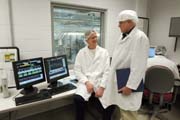
"We wanted to build a functional plant without a lot of new-technology bells and whistles, as was the case at Lakeland and Denver," explains David W. Watson, vice president, engineering and a 21-year Pepperidge veteran who served as project manager on the Lakeland and Denver greenfield developments. "That said, I believe this facility represents the best of engineering at Pepperidge and, I would say, Campbell's."
As head of an 11-member engineering staff, Watson was the project's guiding hand. He and Richard A. Ferguson, senior vice president operations, ushered it through the corporate approval process (see related story on page 68) while relying on work teams to execute the construction, start-up, training and transition aspects of the project. Other key players were Livingstone; Dean Moll, vice president, bakery operations; and R. Glenn Wright, project manager for Bloomfield.
"Closing a plant is a big deal; opening a plant is a big deal," says Livingstone, who served as Norwalk's plant manager before the shutdown. Executing both tasks simultaneously was a challenge made more manageable by the transition of 175 of Norwalk's 360 workers to Bloomfield, which has a staff of 272. High retention levels ensured undisrupted production during Norwalk's final months.
Those operators also brought the art of baking to Bloomfield, where the science of production holds sway. They are a bridge from Norwalk's processes to the new automation. "If there's an upset or breakdown in the process, there is an operator present who is savvy enough to lengthen or shorten the proof time or make other adjustments to ensure we get the product we want," says Wright. "It takes quite a bit of operator input, but adjustments can be made."
Each of Bloomfield's bread lines output 23 percent more volume than the Denver plant's line. Almost 29,000 lbs. of dough per hour can be baked in the three ovens. "We're built to run and to run fast," Livingstone states emphatically, "and to produce more volume of the same quality with less equipment."

Night and day
Norwalk and Bloomfield pose night-and-day comparisons in automation technology: less than a handful of PLCs were deployed at the old plant; the new facility has 39, including 29 ControlLogix units from Rockwell Automation. Fiber optic and CAT 5e cable links those controls with 27 Wonderware thin-client HMIs. More than 200 variable frequency drives (VFDs) communicate through DeviceNet networks, while plant floor I/Os are governed by the ControlNet protocol. "Controls have been taken to the next level," says Wright.
When the Lakeland plant was built, a proprietary control system that became obsolete was installed. At Denver, industry-standard Allen-Bradley controls were deployed, though today's PLCs have much greater processing power and functionality. A few years ago, Lakeland became "our beta site" for the client architecture and HMIs used in Bloomfield, according to Harry S. Pettit, manager of systems engineering. A similar system is being applied in an update to the Denver plant.
Open architecture is a relative term in computer software and hardware; relatively speaking, contemporary controls are much more open than those of a decade ago. As a result, considerably less system debugging occurs when bringing a plant on line. Integration costs for Bloomfield were half those at Denver, Watson estimates. When it's time to add a MES layer to the information technology, "we can bolt it on" without significant reconfiguration costs.
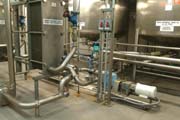
The thin-client HMIs on the production floor essentially are dumb terminals that are easily switched out in case of failure, simplifying maintenance and providing a lower cost of ownership. The HMIs are driven from a control room overlooking the plant's makeup area and networked to corporate and plant-wide systems through eight Cisco switches and backed by seven servers with RAID 5 architecture. This configuration provides excellent system performance, good fault tolerance and a high degree of redundancy.
Bloomfield is the first Pepperidge plant to use Wonderware HMI, which is the HMI standard at Campbell. As a result, the plant is able to tie into a corporate recipe management system that is expected to elevate product consistency to a new level.
Simplified wiring of network controls and devices is an immediate benefit from the open communication standards. Instead of running a wire from an I/O slot in the control room to the equipment on the floor, tags with intuitive names link almost 100 PLCs and other nodes on the Ethernet network to the Wonderware application servers in the control room. System enhancements become more affordable and easier to execute: Pettit foresees the day when condition- monitoring devices will be incorporated into fans and other critical equipment in the plant.
"New plants are demanding this type of technology," says Lionel Bateman, senior design engineer with APV Baker, supplier for most of the equipment from mixers through ovens. Ingredient handling and the bakery's brew system were installed by Shick USA, with The Dennis Group directing the integration effort.
Pepperidge's process is based on no-time dough, an alternative to the sponge-and-dough method that requires floor-time development. Instead of creating the dough in a mixer, then transferring the dough to a trough to allow the yeast and flavors to develop, the brew system delivers bread's flavor profile with a slurry that is 40 percent flour and yeast. The slurry runs through a heat exchanger en route to the bakery's mixers, producing a dough that can immediately move to the makeup line.
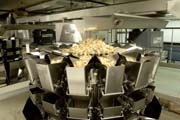
Thanks to the capacity of the multiple tanks in the brew system, Bloomfield can hold the slurry longer than other plants, resulting in a more flavorful brew while delivering 16,000 lbs. an hour to the mixers. Product consistency is improved, and delivery of dough to the dividers is accelerated, boosting output. Positive displacement pumps push the slurry through the exchangers, and three CIP tanks are on hand to clean all elements of the ingredient delivery system. "Whether or not the booster pumps would be sufficient to clean the plate exchangers was quite a point of discussion," says Wright. "We just inspected them, and they were very clean, despite the heavy batter."
Upsized equipment also helps the plant meet its output objectives, from the 2,500-lb. mixers to the double-width makeup lines and the 122-ft. tunnel ovens, longest in the Pepperidge system. The proofers are appropriately oversized, with VFDs to help manipulate dwell time. Dual spiral coolers serve each bread line, a change from the difficult-to-service double spirals used in Norwalk.
The coolers lower the bread's core temperature to 85
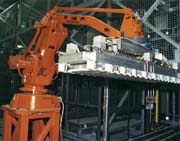
Can-do spirit
The automatic panhandling system lies at "the heart of the productivity side" of the plant, according to Watson, with 12 types of six-strap pans represented in an inventory of 26,000. The system was jeopardized, however, when "the integrator went belly up before we installed the system," he said.
Pans are stored in a space-saving three-tier rack system, with an automatic storage/retrieval crane managing returns and staging pans for upcoming production runs. When a bread-line operator enters an order, the appropriate pans are placed on a conveyor by one of two articulated-arm robots dedicated to that line. A fifth robot provides back up for the two groups of robots.
The robots' gentle handling is expected to extend pan life indefinitely and double the time between pan reglazings to five years. Jams will be virtually eliminated, and instead of the nine operators needed in Norwalk to keep the system running, one worker can oversee the storage/ retrieval system.
The integrator's financial difficulties jeopardized the system's set up, however. Plant engineers had a two-day window to get the equipment out of the integrator's shop before assets were frozen. Technicians from the now-defunct firm followed through with the installation, enabling Pepperidge Farm to stay on track.
Jeremy Kopicz, project engineer with Genesys Controls Corp., was one of three pan-tender technicians who followed through on the project as an independent contractor. He continues to fine tune the system and hopes to eventually tie it into the RMS program to eliminate operator inputs for pans.
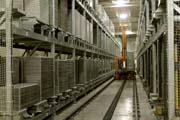
Environmental stewardship is part of the Pepperidge Farm culture; the Denver plant was one of the first U.S. bakeries to incorporate catalytic oxidizers plant-wide to remove ethanol from oven exhaust. Ozone-depleting chemical leaks from refrigeration equipment became a major issue during Bloomfield's construction: a record-setting $5.25 million fine was paid last year by Sara Lee Bakery because of chemical leaks from its refrigeration units. Other processors faced eight-figure liabilities. Pepperidge engineers responded with a mid-project change to install an ammonia system instead of conventional Class 1 or 2 refrigerants as a good-faith gesture to regulators.
Ammonia chilling is a rarity in a fresh-bread operation, particularly north of the Mason-Dixon line. Climate control is critical at the Lakeland, Fla., plant, Wright acknowledges, given ambient air's humidity, which can wreak havoc on the bread-making process. But Northeast bakers are inclined to avoid HVAC's expense and cope as best they can when the dog days of summer arrive.
"HVAC presents some challenges," Wright allows. "Flour dust in the air has to be filtered, and filter maintenance is fairly substantial." Balancing the cost considerations is the environment created for employees. With airborne contaminants virtually eliminated, workers are spared the occupational health issues affecting many bakers. And workers who transferred from Norwalk appreciate the controlled environment. "At Norwalk," remembers Maria Ana Fernandez, a plant engineer, "any change in the weather, you felt it on the floor."

Later this year, Bloomfield will become an early industrial adopter of fuel cell technology. Two 250 KW fuel cells will be installed at the plant. The Connecticut Clean Energy Fund and U.S. Department of Energy are funding the project, and Pennsylvania Power and Light will own and operate the cells. Annual energy savings exceeding $100,000 are expected, and the facility will be less vulnerable to power disruptions. Another $300,000 will be saved through other design elements.
Bloomfield is 85 miles and one light-year away from Norwalk, which straddles the intensely traveled I-95 corridor on the Atlantic seaboard. Managers were pleasantly surprised most of the old plant's workers made the move to semi-rural Bloomfield Township. "The operators really know Pepperidge Farm products and what to expect at the end of the divider, but after seven months, we're still getting trained," Fernandez says. "The good news is, they're providing it."
The training ranges from basic to complex. An eight-week course in English as a second language is offered on site through the community college. The plant's 20 maintenance workers are undergoing intensive electronics instruction to enable them to maintain the plant's advanced automation systems, as well as the mechanical equipment. "We've undergone a lot of training, and we're not through," confesses Maintenance Supervisor Bernard Giorgio.
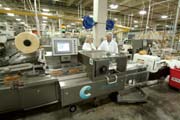
The transition is proceeding smoothly, a fortunate outcome given the company's growth curve. While the Atkins Diet has flattened the overall bread market, Pepperidge Farm's sales are growing at a high single-digit clip. Growth could accelerate implementation of the plant's "future bread" plan: dual use of the roll line for both bun and bread production, and removal of tilt-up panels on the building's north face to expand the facility 60 ft. and add another line.
Accommodating growth was built into the plans devised three years ago, and the infrastructure is in place to facilitate it. "Nothing goes 100 percent smoothly, but this has been a great experience for everybody, and it will pay dividends for Pepperidge Farm," volunteers Wright. Watson seconds that and adds: "This plant is built for efficiency and speed. It produces high volumes of the same high quality that has been the hallmark of Pepperidge Farm since its founding. Accomplishing both those objectives has been the tricky part."
Bringing those parts together in Bloomfield was no trick: it's magic.
For more information:
Lionel Bateman, APV Baker, 919-735-4540
Eric Kaufmann, The Dennis Group, 413-787-1785
Tony Pitrone, The Facility Group, 770-437-2616
topi@facilitygroup.com
Jeremy Kopicz, Genesys Controls Corp., 717-239-5515
jkopicz@genesyscontrols.com
Tony Sollazo, Rockwell Automation, 860-253-4090
Jon Hibschman, Shick USA, 816-861-7224
Sid Adkins, Suitt Construction Co., 919-781-0054
sadkins@suitt.com

